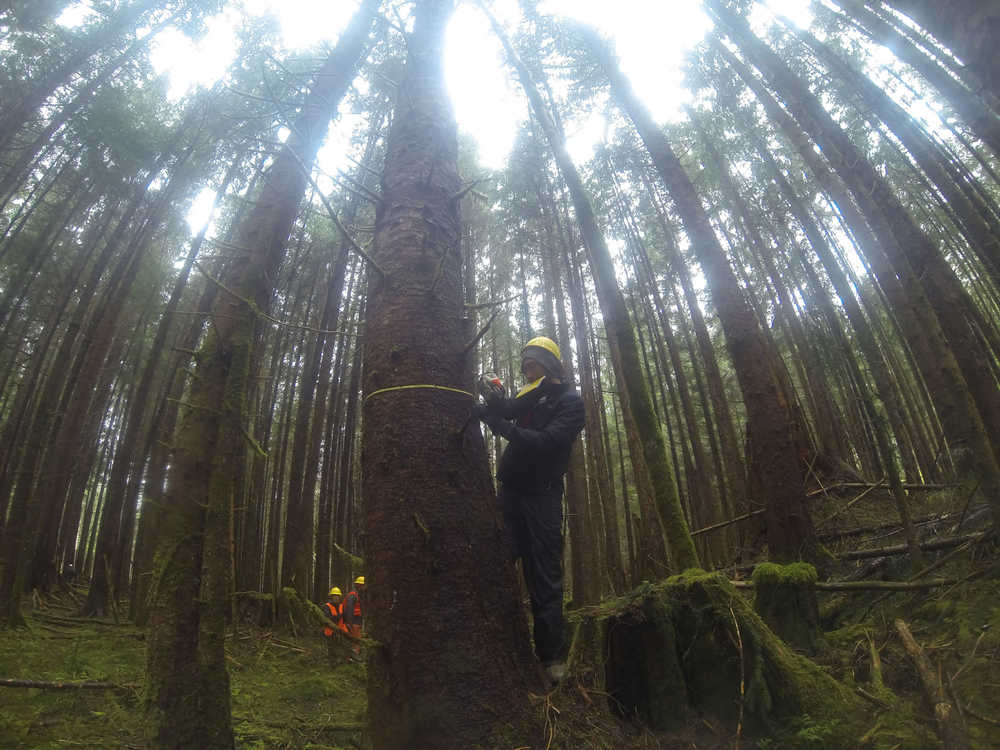April 4 began early for Prince of Wales resident Buck Grasser. A single father of two living in Craig, he was busy getting his children ready for school while hastily checking that he had everything prepared for his first day of training at the Forestry Training Academy. “It’s a long drive from Craig to Thorne Bay, but I’m excited that this opportunity is available,” he said as he buckled his children into the car.
The Forestry Training Academy is an intense two-week course made possible by a collaboration between Sealaska’s Haa Aaní, LLC, the Sustainable Southeast Partnership, Kai Environmental, the United States Forest Service and the State of Alaska. Its goal was to provide Prince of Wales residents with free forestry skills training.
Organizers chose eight people to attend training in Thorne Bay through a competitive application and interview process open to all residents on Prince of Wales Island. The academy covered diverse topics in forestry such as timber inventory, logging operability, protection of fishery and karst resources, and deer habitat enhancement. Skills training included stream and land surveying, land navigation, first aid and CPR, as well as plant and animal identification.
Many of the students were longtime residents of Prince of Wales Island, with families and children, homes and property located around the island. Several of the students, such as Grasser and Tally Carlson of Hydaburg, had to drive several hours to Thorne Bay each morning.
“It’s worth it though,” Grasser said. “This is the kind of thing that Prince of Wales needs. We keep sending people off island to get training and they so rarely come home. Or, if they do, they find that their degrees and schooling aren’t applicable. It’s much better to train us on our home turf for the kind of work being done here.”
The work Grasser mentioned includes the transition from the harvest of old growth timber to young growth timber in the Tongass National Forest, a task that will require continual monitoring and data collection. It also includes the opening up of new economic opportunities for local communities and a more community based approach to resource management. U.S. Forest Service land managers, and industry, will use data collected by the students during their training and afterward to develop better resource management plans that have less environmental impact while supporting growing industries such as tourism.
The amount of opportunity in this field is vast. “One thing that I like about this training is that we’ve been exposed to numerous fields that can be pursued. We’re being trained in general forestry, but it includes geology, hydrology, biology, and a lot of others,” says Michael Melendrez of Craig.
During the second week of the Forestry Training Academy students stepped into the woods near the Harris River Interpretive Site. They were eager to apply the lessons and skills they learned in the classroom to the reality of the woods. The instructor, Carol Mahara of the Thorne Bay Ranger District, gathered the students around her, ankle-deep in a stream. She rapidly pointed out its various features as the students identified them or asked questions for clarity. Then with a quick “Get to it!” Mahara turned the students loose.
The students, who ranged in age from 21 to 51, broke into two person teams, strung surveying tape across various points of the stream, and took measurements. They measured bank height, stream gradient, and streambed substrate as Mahara moved from team to team giving advice or asking clarification.
As each team finished its survey of the reach, or section of a stream, Mahara moved them downstream, stopping to point out features and changes. As the teams finished data collection for the morning, Mahara turned the students over to the next instructor.
“They’re a great group,” Mahara said. “They’re locals — most grew up here and know the areas that they’ll be physically working in already. That’s great.” She laughed and added, “There’s less chance that they’ll get lost. But seriously, this is the perfect application of using local knowledge to manage local lands.”
Mahara’s comment reflects a growing trend in Southeast Alaska, one that is being supported and developed through the collaborative efforts of land managers, local tribes and regional partnerships. The goal is to keep more money, more opportunity and more expertise, closer to home. Training and teaching locals to be more involved and proactive in fields that have typically been filled by a non-local workforce is a step forward for Prince of Wales residents seeking career opportunities at competitive wages.
Alana Peterson of Sealaska’s Haa Aani, LLC, said “This needed shift of local management of our lands on Prince of Wales is an example of how all communities in Southeast Alaska can reach self-determination. If we know the most about our lands and resources, we will be the best stewards of the land because we live here… This is stewardship in action.”
Forestry Training Academy student Harrison Voegeli of Craig’s words reflect that sentiment as well. “Train us at home and we’ll work for our homes. We’re closer to these areas than anyone else… Why wouldn’t we be? We live here for a reason. Train us and we’ll prosper. Make this training mean something,” he said.
While only eight students out of roughly thirty applicants were chosen this round, the number of applicants that were submitted shows that residents of Prince of Wales Island are turning their eyes toward the future of the island and being more proactive in how the lands they call home are managed.
• Quinn Aboudara is a lifelong resident of Prince of Wales Island and can often be found wandering the woods and waters of his home. He may be contacted at the Sustainable Southeast Partnership office of the Klawock Cooperative Association or by email: kcacatalyst@klawocktribe.org

